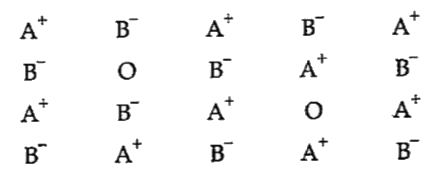What type of stoichiometric defects are noticed in crystals?
To answer the question regarding the types of stoichiometric defects in crystals, we can break down the solution into clear steps:
1. Definition of Stoichiometric Defects:
- Stoichiometric defects are imperfections in the crystal structure that do not change the overall composition of the crystal. They can occur due to the absence of ions in the lattice.
2. Types of Stoichiometric Defects:
- There are two main types of stoichiometric defects: Schottky Defect and Frenkel Defect.
3. Schottky Defect:
- In a Schottky defect, an equal number of cations and anions are missing from the crystal lattice.
- For example, in an AB type crystal (where A is a cation and B is an anion), one cation (A⁺) and one anion (B⁻) are removed from their respective lattice sites.
- This results in a decrease in the density of the crystal because there are fewer ions present in the lattice.
- The electrical conductivity of the crystal increases due to the presence of more free charge carriers.
4. Frenkel Defect:
- In a Frenkel defect, a smaller cation is displaced from its lattice position to an interstitial site within the crystal.
- For instance, in an AB type crystal, a cation (A⁺) moves from its lattice site to an interstitial site, leaving a vacancy behind.
- The overall mass of the crystal remains the same, so the density does not change significantly.
- The electrical conductivity may slightly increase due to the presence of the displaced ion in the interstitial site.
5. Summary:
- The two types of stoichiometric defects are:
- Schottky Defect: Equal number of cations and anions missing, leading to decreased density and increased conductivity.
- Frenkel Defect: Smaller cations displaced to interstitial sites, keeping density constant and slightly increasing conductivity.
- Stoichiometric defects are imperfections in the crystal structure that do not change the overall composition of the crystal. They can occur due to the absence of ions in the lattice.
- There are two main types of stoichiometric defects: Schottky Defect and Frenkel Defect.
- In a Schottky defect, an equal number of cations and anions are missing from the crystal lattice.
- For example, in an AB type crystal (where A is a cation and B is an anion), one cation (A⁺) and one anion (B⁻) are removed from their respective lattice sites.
- This results in a decrease in the density of the crystal because there are fewer ions present in the lattice.
- The electrical conductivity of the crystal increases due to the presence of more free charge carriers.
- In a Frenkel defect, a smaller cation is displaced from its lattice position to an interstitial site within the crystal.
- For instance, in an AB type crystal, a cation (A⁺) moves from its lattice site to an interstitial site, leaving a vacancy behind.
- The overall mass of the crystal remains the same, so the density does not change significantly.
- The electrical conductivity may slightly increase due to the presence of the displaced ion in the interstitial site.
- The two types of stoichiometric defects are:
- Schottky Defect: Equal number of cations and anions missing, leading to decreased density and increased conductivity.
- Frenkel Defect: Smaller cations displaced to interstitial sites, keeping density constant and slightly increasing conductivity.
Similar Questions
Examiine the given defective crystal

(i) What type of stoichiometric defect is shown by the the crystal ?
(ii) How is the density of the crystal affected by this defect ?
(iii) What type of ionic substance show such defect ?
View SolutionA sample of ferrous oxide has actual formula Fe0.93O1..00. In this sample what fraction of metal ions are Fe2+ ions? What type of non-stoichiometric defect is present in this sample ?
View Solution
Knowledge Check
Examine the given defected crystal

Answer the following questions:
What type of stoichiometric defect is shown in the crystal ?ASchottky defect, decreases, NaCl and KCl etcBFrenkel defect, increases, As and Si etcCSchottky defect, increases, As and Bi etcDFrenkel defect, decreases, NaCl, KCl etcWhat type of stoichiometric defecit is shoen by ZnS ?
ASchottky defectBFrenkel defectCBoth Frenkel and Schottky defectsDNon-stoichiometric defectA sample of ferrous oxide has actual formula Fe0.93O1..00. In this sample what fraction of metal ions are Fe2+ ions? What type of non-stoichiometric defect is present in this sample ?
A(i)-0.849 , (ii)-Metal deficiencyB(i)-0.790 , (ii)-Metal deficiencyC(i)-0.145, (ii)-Metal excessD(i)-0.93 , (ii)-Vacancy defect
What type of stoichiometric defect is shown by AgCl?
View SolutionWhat type of stoichiometric defect is shown by AgCl ?
View SolutionStoichiometric defect is also known as
View SolutionF-centre defect is noticed in:
View SolutionWhat type of stoichiometric defect is shown by NaCl ? Explain.
View Solution